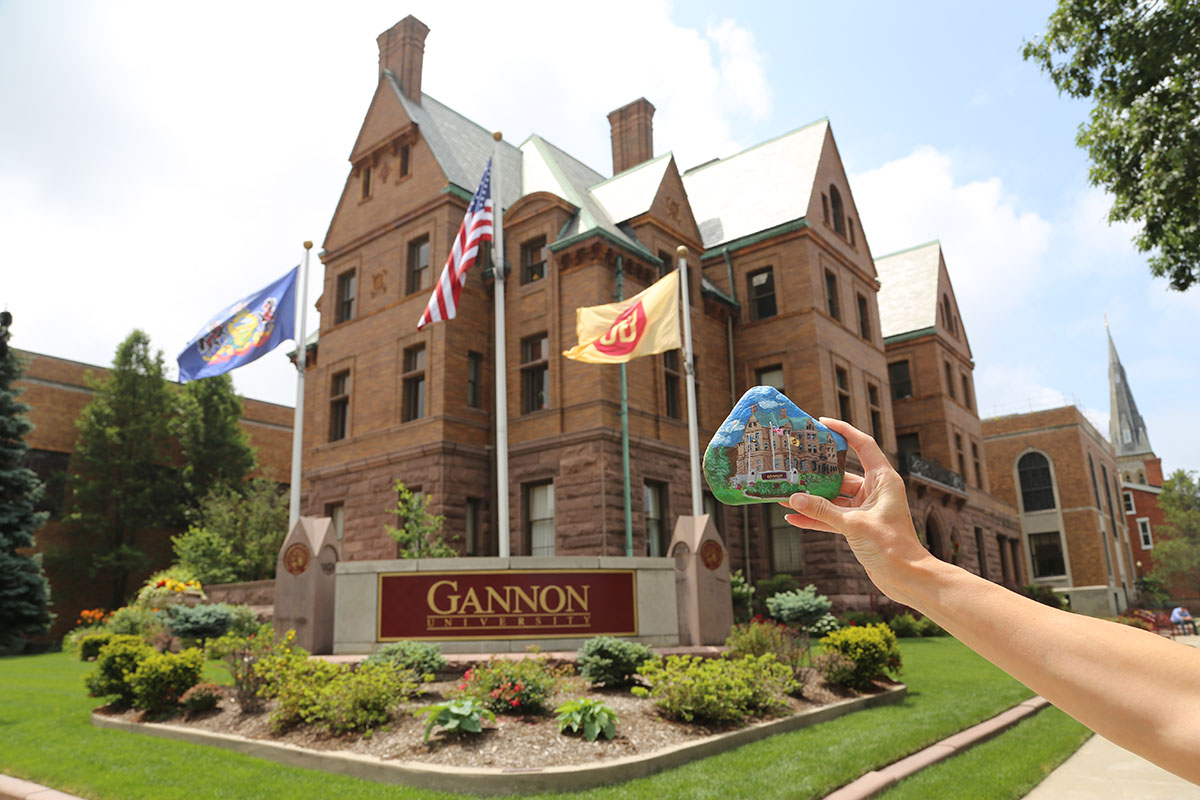Walking in to the Erie Art Museum is always an exercise in unifying contrast.
Tucked away in one of the oldest-looking parts of the city, the new entrance to the old museum at 10 E. Fifth St. is imposing and modern, yet integrated and throwback. Its light-brownish bricks blend seamlessly with buildings on blocks close by, and the blue collar, blue metallic adornment perched upon it – when viewed from afar – evokes the idea of a giant metal sleeve sliding high into the Erie air, revealing a futuristic 1960s-era strip-mall storefront bedecked with glass and metal below.
It is both contemporary, and ancient.
This entrance, this museum – they both have an eye on Erie’s proud past but haven’t lost sight of her bright future. And one talented local artist with a knack for business melded with a love of local lore found a way to give future generations of Erieites a visual representation of both space and time that’s as simple as black and white.
“HIGHERglyphics: The Annex Stairwell Project” simultaneously highlights Erie’s proud past – from DNA to today, and beyond – while also pondering her bright future through a QR-code infused daydream that covers more than 1,200 square feet. And while everyone’s aware of the museum’s prestigious upcoming event – the 90th Annual Spring Show – HIGHERglyphics is not technically part of that exhibit; it’s actually part of the building
“This stuff happens in more of an intuitive sense,” says Todd Scalise, who is contemplating the grey sky on an early April Erie day. Rain – soaking at times –intermittently drenches pedestrians under umbrellas, the sterile, orderly sheen of the Erie Art Museum windows separating him and them. It’s warm-ish for the season – 44 degrees – but the stinging rain and gusty winds reduce walking to a most unpleasant pleasure.
“I make a lot of work, and through that work the style emerges, and I wait for that.” Scalise is seated at one of the tables near the museum café, looking out on East Fifth Street, and thinking aloud more than speaking. He’s a contemplative guy, but not overly detached from reality. When he speaks, he strikes a nice balance between thewhat is, and the what could be.
Scalise grew up in Erie, graduating from Mercyhurst High School 1991. He earned his Bachelor of Fine Arts in painting at Temple University’s Tyler School of Art in 1995 and his Master of Fine Arts at Boston University 1997, also in painting. After more travelling and studying, Todd found himself working in New Mexico in 2007.
“I was making very colorful, abstract paintings,” says Scalise, of his Sante Fe days. “I decided that painting was what I wanted to do with my life. I had taught as a professor [at Robert Morris and Duquesne in Pittsburgh, and then at Eastern New Mexico University in Portales] and I was moonlighting as a painter, and I thought, ‘I need to reverse this.’”
With his waking mind focused on attaining the satisfaction of creative freedom, his subconscious mind was instead subjected to immersion in the distinctive art produced by the native peoples of the American Southwest – basketry and bowls, paintings and pottery, weavings and wearables with a primitive-yet-sophisticated style and simple color palette. This style had a profound effect on him, an effect that didn’t really crystallize until he returned from Europe to Erie in 2010 and started experimenting with a different style that was modern yet ancient – refined yet raw, black and white. That style would become known as HIGHERglyphics.
“It’s not much different from southwestern graphic systems, which are basically carbon on white,” Scalise says, gesturing to a display case of southwestern art 20 feet from his fingertips. “It’s really basic – it’s binary. It’s black on white.”
Binary. Black on white. It either is, or is not. There’s no shading, and, unlike the sky he’s gone back to looking at, there is no grey. This ancient, efficient mode of conveying thoughts and ideas is also, incidentally, the premise upon which a personal computer operates. But thousands of years ago, American Indians of the American Southwest found an abundance of natural materials that could efficiently create strong, sturdy blacks and wispy, watery whites, so they used them abundantly.
“I use Sharpie markers. It’s the most simple, and the most efficient, the most available, and it really helps me clear out all the ‘arty-ness’ of my art,” says Scalise, waving one of his trusty markers through the air like a magic wand. “It got rid of all the painterly elements and refined it to the most basic elemental things that need to happen – which are imagery and meaning….”
This excerpt was from an article by Cory Vaillancourt, originally published in the Erie Reader on Apr. 17, 2013. You can find the rest of this article here.





0 Comments